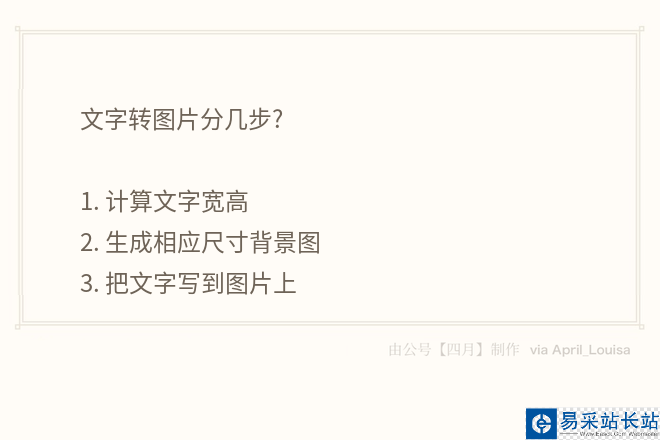前言
最近有文字转图片的需求,但是不太想下载 APP,就使用 Python Pillow 实现了一个,效果如下:

PIL 提供了 PIL.ImageDraw.ImageDraw.text 方法,可以方便的把文字写到图片上,简单示例如下:
from PIL import Image, ImageDraw, ImageFont# get an imagebase = Image.open('Pillow/Tests/images/hopper.png').convert('RGBA')# make a blank image for the text, initialized to transparent text colortxt = Image.new('RGBA', base.size, (255,255,255,0))# get a fontfnt = ImageFont.truetype('Pillow/Tests/fonts/FreeMono.ttf', 40)# get a drawing contextd = ImageDraw.Draw(txt)# draw text, half opacityd.text((10,10), "Hello", font=fnt, fill=(255,255,255,128))# draw text, full opacityd.text((10,60), "World", font=fnt, fill=(255,255,255,255))out = Image.alpha_composite(base, txt)out.show()为什么要计算文字的宽高呢?把文字直接写到背景图不可以么?
Pillow PIL.ImageDraw.ImageDraw.text 写文字是按换行符 /n 换行的,如果个字符串特别长,文字部分就会超出背景图的宽度,所以第一步我们需要先把文本按固定的宽度计算出高度。
像图上写的这样,文字转图片分三步:
计算文字宽高 生成响应尺寸背景图 把文字写到图片上计算文字宽高
这里背景图宽度是固定的,所以文字的宽可以不用计算。 PIL.ImageDraw.ImageDraw.text 是通过 /n 来换行的,那我们只需要在文字合适的位置加上 /n 就可以了。
第一个想到的是 textwrap 方法,textwrap 可以实现通过调整换行符的位置来格式化文本。但 textwrap 还有一个问题就是它是根据字符长度来分隔的,但文本中的字符并不是等宽的,通过 textwrap 格式化后的文字写到图片上效果可能是这样的:

使用这种方式,如果我们要调整字体大小,每一行的长度都还需要再重新调整。
为了保证每一行宽度尽可能的一致,这里使用 PIL.ImageDraw.ImageDraw.textsize 获取字符宽高,然后按约定宽度把长文本分隔成文本列表,然后把列表每行文字写到图片上。
def get_paragraph(text, note_width): # 把每段文字按约定宽度分隔成几行 txt = Image.new('RGBA', (100, 100), (255, 255, 255, 0)) # get a drawing context draw = ImageDraw.Draw(txt) paragraph, sum_width = '', 0 line_numbers, line_height = 1, 0 for char in text: w, h = draw.textsize(char, font) sum_width += w if sum_width > note_width: line_numbers += 1 sum_width = 0 paragraph += '/n' paragraph += char line_height = max(h, line_height) if not paragraph.endswith('/n'): paragraph += '/n' return paragraph, line_height, line_numbersdef split_text(text): # 将文本按规定宽度分组 max_line_height, total_lines = 0, 0 paragraphs = [] for t in text.split('/n'): # 先按 /n 把文本分段 paragraph, line_height, line_numbers = get_paragraph(t) max_line_height = max(line_height, max_line_height) total_lines += line_numbers paragraphs.append((paragraph, line_numbers)) line_height = max_line_height total_height = total_lines * line_height # 这里返回分好的段,文本总高度以及行高 return paragraphs, total_height, line_height
新闻热点
疑难解答